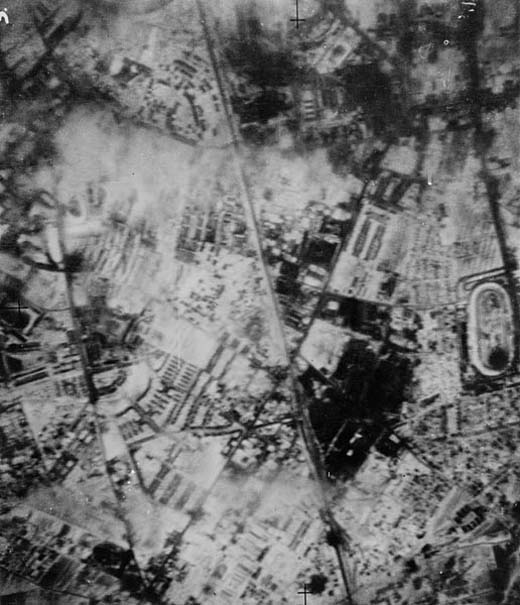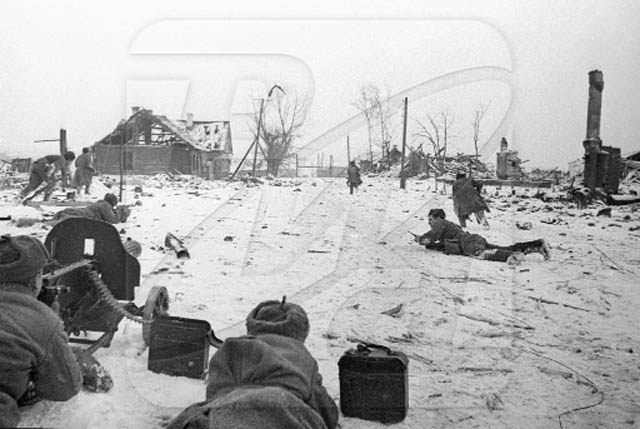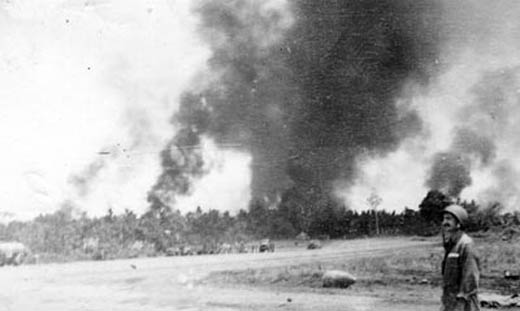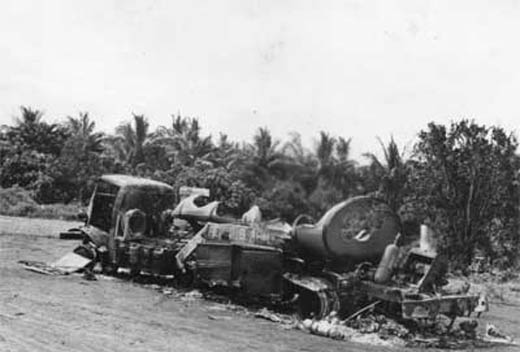Air Operations, Bismarcks
- 43rd Heavy Bomb Group B-17s attack the airfield and port facilities at Rabaul.
- 90th Heavy Bomb Group B-24s mount single-plane attacks against the Gasmata airfield on New Britain and on a cargo ship at sea.
Air Operations, CBI
BURMA- 3 341st Medium Bomb Group B-25s based in India attack the rail center at Maymyo and 3 other B-25s attack rail lines north of the town.
Air Operations, Europe
During the night the Germans bomb London in its first night raid since May 1941. This is a 'reprisal' raid by the Luftwaffe. 118 aircraft attack in 2 waves. Bombs fall mainly on the outskirts. The Greenwich power station is hit. 6 planes are lost. 23 people are killed.
BOMBER COMMANDEvening Ops:
- 170 Lancasters and 17 Halifaxes repeat the previous night's raid on Berling.
- The weather is better but the Pathfinders again fail to mark the city center and most of the bombs fall in the southern districts. There is no damage of any note in Berlin, but the BMW aero-engine factory in Spandau is hit by incendiaries and is slightly damaged. This is the last raid on Berlin using target indicators. Bomber Command will not return until the H2S radar is ready.
- Following the same route as the previous night, the German nightfighters are able to locate the bomber stream.
- 19 Lancasters and 3 Halifaxes are lost.
Fires in Berlin |
 |
Air Operations, Libya
IX Bomber Command B-24s attack the harbor at Tripoli, and 9th Air Force P-40s undertake fighter-bomber missions in support of the British 8th Army advance.
[Air Operations, Mediterranean
While escorting XII Bomber Command B-25s on an anti-shipping sweep to Sicily, P-38 pilots of the 82nd Fighter Group's 97th Fighter Squadron down 2 Ju-52s and 1 Ju-88 encountered along the way. The B-25s fail to locate any targets.
[Air Operations, New Guinea
- V Bomber Command B-25s attack the supply dumps at Lae.
- 90th Heavy Bomb Group B-24s mount single-plane attacks on the Malahang airfield at Lae and the port facilities at Finschhafen and Madang.
- 3rd Light Bomb Group A-20s attack Japanese Army ground forces near Salamaua and in the Mambare River delta.
- An 8th Fighter Group P-39 downs a Japanese bomber near Ferguson Island at 1310 hours. 3 other bombers are damaged by other P-39s in the same action.
- During the afternoon, a Japanese air raid by 24 G4M1 Betty bombers escorted by 20 A6M Zeros arrives at 1240. The bombers drop 230-250 x 100kg bombs onto Turnbull Field (No. 3 Strip) at Milne Bay. Destroyed on the ground are 2 B-17s, 1 B-24, 2 P-39s, 1 RAAF Hudson bomber as well as several fuel dumps and vehicles. Several aircraft are damaged, but later repaired. No one is killed, but eight are wounded from the 49th Serivce Squadron.
Air Operations, Solomons
347th Fighter Group P-39s attack Japanese Army ground troops on Guadalcanal.
[Air Operations, Tunisia
XII Bomber Command B-25s attack the rail junction at Graiba.
[Burma
Commonwealth forces occupy Kyauktaw (Arakan).
[Eastern Front
Again there are Russian gains along the front from Orel to the Caucasus. Millerovo and Zimovniki are captured. Around Stalingrad there is a slight lull as the Russians regroup for the final push.
The German High Command belatedly admits the loss of Velikie Luki (see January 1, 1943) after repeated counterattacks have failed to take the town.
|
|
The entire southern front sees movement. From Novosil to the Caucasus no fewer that 13 Russan armies, not counting the 7 engaged in the liquidation of Stalingrad, are on the move. The weakest sector is that on the Don, held by the Hungarian 2nd Army, engaged by the Russian 40th Army and 2nd Armored Army, the Italian 8th Army, in danger of encirclement by the Russian 6th Army and the 1st Assault Group, and the Rumanian 3rd Army, faced by the 3rd Assault Group and the 5th Armored Army.
SOUTHERN SECTORChertkovo falls to the Soviets after a bitter struggle.
In the Stalingrad pocket 6th Army struggles to survive. Over half the pocket and 10,000 prisoners have fallen to the Red Army, leaving 6th Army in possession of only one of the six airfields. Supplies now have to air dropped and many containers fall into deep snow. Of those dropped in the correct areas, many can not be recovered becaust of the physical exhaustion of the German soldiers. The battle so far has cost the Don Front dear. Pausing to regroup, Rokossovsky again offers 6th Army the opportunity to surrender but yet again Paulus refuses, as instructed by Hitler.
In the Caucasus 47th Army joins the Soviet offensive.
[Guadalcanal
The 8th Marines, 2nd Marine Div, upon clearing the ravine west of Hills 80 and 81 and moving forward to positions abreast the 6th Marines, withdraws from the line to the perimeter defense. In 5 days, the 2nd Marine Division has gained about 1,500 yards. It reports 643 Japanese killed, 2 prisoners, plus a quantity of guns and ammo.
The coastal attack, which has gained almost a mile beyond Point Cruz since the 13th, is to be continued by the 182nd Infantry on the left and the 6th Marines on the right. The 182nd Infantry, less the 3rd Battalion, moves into the CAM Div line. After several attempts are made via loud speaker broadcasts to get the Japanese on the Gifu to surrender, the last coming this morning, but no one did. The 2nd Battalion, 35th Infantry, pulls back while a 2 and one half hour artillery bombardment is placed on the strongpoint. 49 howitzers place over 1,700 rounds in an area less than 1,000 yards square. After the bombardment, about 1630, infantrymen moved forward to reoccupy their lines, having been withdrawn a few hundred yards for the artillery bombardment. Since darkness is approaching rapidly, the ground attack is withheld. The 27th Infantry, 25th Div, which is to conduct a holding action during the corps' coming offensive while the 161st Infantry makes the main effort, begins a forward movement. C Company, with the light machine gun section attached, takes up postions on a ridge southwest of Hill 66, called Snake.
[New Guinea
Advance elements of the Australian 17th Brigade are flown to Wau. Brig M.J. Moten, CG Australian 17th Brigade, takes command of Kanga Force. The Australian 18th Brigade continues to clear the coast region between Wye Point and Giruwa. Sanananda Village and Point are overrun, but the enemy retains positions west and south of Sanananda and in the outskirts of Giruwa. On the Soputa-Sanananda road, the US 163rd Infantry probes enemy defenses north of Fisk. The US 127th Infantry, replacing the 1st Battalion with the 2nd, continues west along the coastal road toward Giruwa, handicapped by extremely difficult and skillfully defended terrain. The 3rd Battalion pushes south along the Konombi Creek and encounters an enemy outpost.
|
|
Japanese air raid by 24 G4M1 Betty bombers escorted by 20 A6M Zeros arrive at 12:40 local time. The bombers dropped 230-250 x 100kg bombs onto Turnbull Field (No. 3 Strip). Destroyed on the ground are B-17F "Fire Ball Mail" 41-24551, B-17F 41-24540, P-39D 41-38485, P-39D ??-????, B-24D "Aincha Sorry" 41-23824 and two C-47s all destroyed on the ground. Also, 6 vehicles and 6 fuel dumps. Damaged are Hudson A16-206, Hudson A16-239 and Hudson A16-185 had its ailerons and wireless transmitter damaged, but was later repaired. No one is killed, but eight are wounded from the 49th Serivce Squadron.
[North Africa
ALGERIATask Force SATIN of the US II Corps moves forward in preparation for its drive on Sfax, but the operation is canceled.
LIBYAThe British 8th Army pursues the enemy to the west toward Tripoli, but progress is hampered by the desert terrain as well as by mines and demolitions. Coastal forces reach an area 10 miles from Misurata. The southern column reaches Ben Ulid.
[


